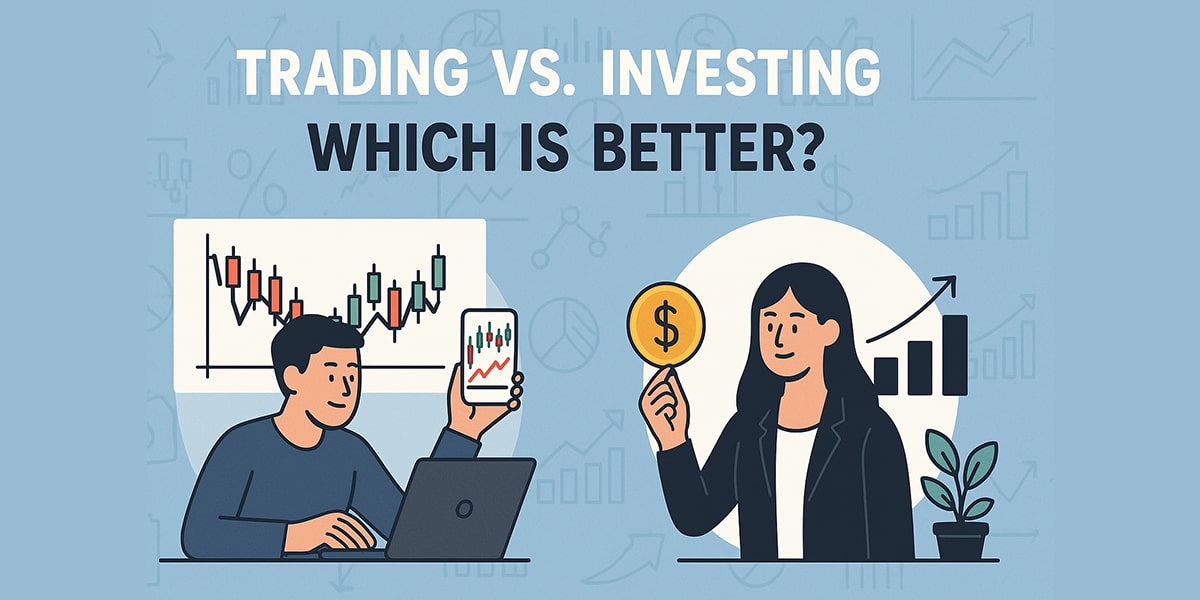20 March 2024
Stock trading and investing: Key differences and methods
The goal of stock trading and investing is to benefit financially from a favorable change in the price of a stock or portfolio of stocks. However, that is where most of the similarities end. Stock trading and investing can differ greatly in their approaches and methods.
Investing usually involves the physical purchase of shares through a stock account, while stock traders simply seek to take a speculative position in the underlying market, which may be represented by the shares themselves or related derivatives such as options contracts.

What does stock trading involve?
There are five key points to emphasize when comparing trading and investing:
- 1) Purpose
- 2) Time horizon
- 3) Capital
- 4) Analysis
- 5) Risk
1) Objective (capitalizing on short-term price movements)
Stock traders usually seek to capitalize on speculative positions by focusing on short to medium term price movements. They often jump in and out of stocks and seek to capitalize on short-term movements in the market. For example, protracted trade negotiations can disrupt the production and sales of export companies, causing the stock price to fall.
As this information "settles" into the stock price, a downtrend or sell-off may develop, on which a short-term trader may try to capitalize by taking a short position in the relevant stock or index.
2) Time horizon (short and medium term)
While investors tend to work for the long term, stock traders usually focus on short and medium term trades. Stock trading often utilizes approaches such as scalping and day trading, which allow traders to achieve faster results because they can enter and exit multiple trades on the same day.
3) Initial capital expenditures
Exchange traders only need to finance a portion of the cost of their trades according to the margin requirement. For example, if a stock is worth $10 and a trader wants to trade 100 shares, he or she will only need $500 to open a trade when the margin requirement is 50%. It should be noted that traders should always make sure that the trading account is sufficiently funded to account for unfavorable price movement once the trade is initiated, and always use a stop loss.
Investors, on the other hand, are often reluctant to use margin or leverage because paying interest on borrowed capital can reduce the long-term returns from owning a stock.
4) Analysis (technical or fundamental)
Traders tend to use either technical or fundamental analysis or a combination of the two, which means that in the debate between technical and fundamental analysis, there is no clear-cut answer as to which is better.
Popular tools used by technical stock traders include:
200-day moving average (trend filter) analysis on multiple time frames MACD stochastic oscillator support and resistance.
Stock traders can use fundamental data to form an opinion on the attractiveness of a stock to trade (short or long). If a company has good fundamentals, traders may seek to go long, and if it has poor fundamentals, traders may seek to go short.
Fundamental factors of interest to stock traders:
Earnings releases Stock ratios (P/E, dividend yield, etc.) Debt-to-equity levels Possible takeovers or acquisitions
5) Risk
In general, stock traders may face a higher relative level of risk due to the increased use of leverage. While leverage can help generate large profits, it can also work against the trader, causing large losses. The use of leverage can wipe out an account faster and leave the trader owing more than the amount originally deposited. It is always recommended to use stops to limit losses.

Trading and investing: Which is better?
In the debate between trading and investing, there is no empirical evidence that one approach is superior to the other. In a way, this insight is reassuring because each person can choose the approach that they feel best suits their individual goals and objectives. Recognize your individuality and make sure it complements your approach to the financial markets, whether it is short-term trading or long-term investing.
👀 Related Articles:


